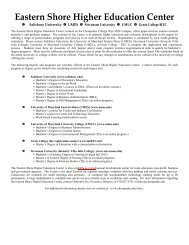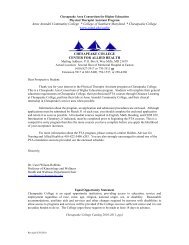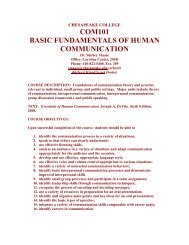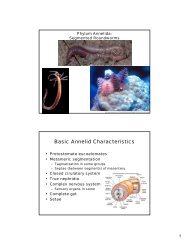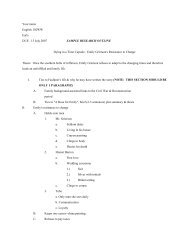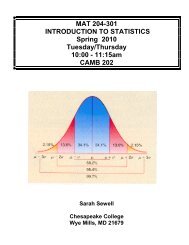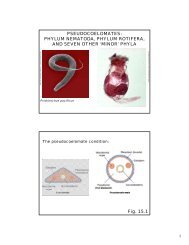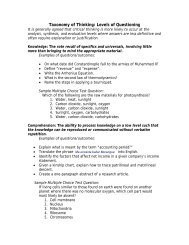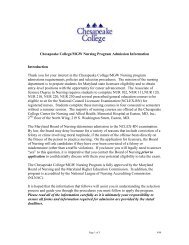Patterns of Inheritance
Patterns of Inheritance
Patterns of Inheritance
Create successful ePaper yourself
Turn your PDF publications into a flip-book with our unique Google optimized e-Paper software.
<strong>Patterns</strong> <strong>of</strong> <strong>Inheritance</strong>What is inheritance?Parents passgeneticinformation on to<strong>of</strong>fspring.Sexual reproduction- <strong>of</strong>fspring inheritcharacteristics fromboth parents to forma unique individualEven long ago, breeding for traits was awell established practice.http://maccentral.macworld.com/news/0005/images/Koi.jpgwww.pitchfork.com/morgan.jpgSelective breeding wascommon among farm animals,plants, and pets.http://kboriginals.8m.com/images/roses-_539-_internet_version.jpgwww.sarcenet.comhttp://www.jeannieshouse.com/kennel/sheepdog/sheepdog.jpghttp://www.illusionmasks.com/images3/maize.jpg1
In 1866, the world was a different place...Gregor Mendel was anAustrian monk and theson <strong>of</strong> a farmer. He wasfamiliar with the concept<strong>of</strong> breeding, or crossingadult organisms toachieve a desired look inthe <strong>of</strong>fspring.http://www.mpiz-koeln.mpg.de/~stueber/mendel/mendel.jpg• He also usedhis knowledge<strong>of</strong> statisticsandmathematics todeduce thefundamentalprinciples <strong>of</strong>geneticsSome traits were obviously inherited –but how?Mendel wanted to understand howtraits were passed from onegeneration to another. So he chosepeas, which have a number <strong>of</strong> veryhandy characteristics.http://www.mpiz-koeln.mpg.de/~stueber/mendel/mendel.jpghttp://www.blc.arizona.edu/courses/181gh/rick/genetics1/graphics/pea_traits.gif2
LE 9-2dFlower colorPurpleWhiteFlower positionAxialTerminalSeed colorYellowGreenSeed shapeRoundWrinkledPod shapeInflatedConstrictedPod colorGreenYellowStem lengthTallDwarfcarpelovule(female)stamens-pollen(male)Sexual reproduction in peaMendel crossed peaplants that differed incertain characteristicsor “traits”Easy to grow and mateDeveloped true-breedingvarietiesTraced traits fromgeneration to generationLE 9-2cRemoved stamensfrom purpleflowerWhiteStamensParents(P)CarpelTransferred pollenfrom stamens <strong>of</strong>Purplewhite flower tocarpel <strong>of</strong> purpleflowerPollinated carpelmatured into podPlanted seedsfrom podOffspring(F 1)3
• P generation: true-breeding parents• F1 generation: hybrid <strong>of</strong>fspring <strong>of</strong> true-breedingparents (first generation)• F2 generation: <strong>of</strong>fspring <strong>of</strong> self-fertilizing F1parents (second generation)• Mendel's Law <strong>of</strong> Segregation describes theinheritance <strong>of</strong> a single characteristic– From his experimental data, Mendel developedseveral hypotheses• There are alternate forms <strong>of</strong> genes that account forvariation in inherited traits. These variations are calledalleles.• For each trait, an individual inherits two alleles, one fromeach parent. The alleles may be the same or different• A gamete carries only one allele for each inherited trait,because allele pairs segregate (separate) from each otherduring gamete production• Fertilization gives each new individual 2 alleles for eachtraitWe now know...– Alternate forms <strong>of</strong> a gene responsible for agiven trait are called alleles– These reside at the same position (locus) onhomologous chromosomes– Individuals carry 2 alleles for a given trait (onefrom each parent)– An allele that is able to mask the expression <strong>of</strong>the other allele at the same location = dominant– The allele that is masked or hidden = recessive4
Homologous pair <strong>of</strong> chromosomesALLELES (twodifferent forms <strong>of</strong>the same gene)www.niddk.nih.gov/.../sum00/ images/chromosome.gifIf alleles are the same, they are said to be homozygousHomozygous dominant DDHomozygous recessive ddIf the alleles differ, only the dominant is expressedHeterozygous DdAn organism's appearance does not always revealits genetic compositionGenotype: Genetic makeupPhenotype: Expressed (physical) traitsLE 9-4Gene lociP a BDominantalleleGenotype:P a bPPHomozygousfor thedominant alleleaaHomozygousfor therecessive alleleBbHeterozygousRecessiveallele5
LE 9-3aP generation(true-breedingparents)×Purple flowersWhite flowersF 1 generationAll plants havepurple flowersFertilizationamong F 1 plants(F 1 × F 1 )F 2 generation3<strong>of</strong> plants4have purple flowers1<strong>of</strong> plants4have white flowersLE 9-3bP plantsPPGenetic makeup (alleles)ppGametesAll PAll pF 1 plants(hybrids)All PpGametes12P12 pPSpermpF 2 plantsPhenotypic ratio3 purple : 1 whitePPPPpGenotypic ratio1 PP : 2 Pp : 1 ppEggspPpppMonohybrid Cross - cross individuals differing inonly one traitParents X nnNNHomozygousdominantHomozygousrecessiveWe can use a Punnett Square to look at all thepotential combinations <strong>of</strong> genotypes that canoccur for 2 parents.6
• Geneticists use the testcross to determineunknown genotypes– A monohybrid testcross can reveal if an individualwith a dominant phenotype is homozygous orheterozygous• Mate an individual <strong>of</strong> unknown genotype and ahomozygous-recessive individual• Each <strong>of</strong> the two possible genotypes (homozygous orheterozygous) gives a different phenotypic ratio in the F 1generationLE 9-6Testcross:×GenotypesB_bbBBTwo possibilities for the black dog:orBbGametesBBbbBb b Bb bbOffspring All black 1 black : 1 chocolateMendel went on to cross plants differing in twotraits...• The law <strong>of</strong> independent assortment is revealed bytracking two characteristics at once– Dihybrid cross• Mate true-breeding parents differing in two characteristics•The F 1generation exhibits only the dominant phenotype•The F 2generation exhibits a phenotypic ratio <strong>of</strong> 9:3:3:1– Mendel's Law <strong>of</strong> Independent Assortment: each pair <strong>of</strong>alleles segregates independently <strong>of</strong> other allele pairsduring gamete formation - the two traits are inheritedindependently– All possible combinations can occur in the gametes7
LE 9-5aHypothesis: Dependent assortmentP generation RRYYrryyHypothesis: Independent assortmentRRYYrryyGametesRYryGametes RY ×ryF 1 generationRrYyRrYySpermSperm12 RY1ry 21 11 14 RY 4 rY 4 Ry 4 ryF 2 generation12 RYEggs12 ryActual resultscontradict hypothesis14 RYRRYY RrYY RRYy RrYy14 rYRrYY rrYY RrYy rrYyEggs1Ry 4RRYy RrYy RRyy Rryy14 ryRrYy rrYy Rryy rryyActual resultssupport hypothesis916316316116YellowroundGreenroundYellowwrinkledGreenwrinkledDihybrid Cross - two trait crossParents TTGG X ttggLE 9-5bBlindBlindPhenotypesGenotypesBlack coat, normal visionB_N_Black coat, blind (PRA)B_nnChocolate coat, normal vision Chocolate coat, blind (PRA)bbN_bbnnMating <strong>of</strong> heterozygotes(black, normal vision)BbNn×BbNnPhenotypic ratio<strong>of</strong> <strong>of</strong>fspring9 black coat,normal vision3 black coat,blind (PRA)3 chocolate coat,normal vision1 chocolate coat,blind (PRA)8
• Mendel's laws reflect the rules <strong>of</strong> probability– Events that follow probability rules are independentevents• One such event does not influence the outcome <strong>of</strong> a later suchevent– The rule <strong>of</strong> multiplication: The probability <strong>of</strong> two eventsoccurring together is the product <strong>of</strong> the separateprobabilities <strong>of</strong> the independent events– The rule <strong>of</strong> addition: The probability that an event canoccur in two or more alternative ways is the sum <strong>of</strong> theseparate probabilities <strong>of</strong> the different waysLE 9-7F 1 genotypesBb maleFormation <strong>of</strong> spermBb femaleFormation <strong>of</strong> eggs12B12b12BB B B bF 2 genotypes141412bb B b b1414• Genetic traits in humans can be tracked throughfamily pedigrees– The inheritance <strong>of</strong> many human traits followsMendel's laws• The dominant phenotype results from either theheterozygous or homozygous genotype• The recessive phenotype results from only thehomozygous genotype– Family pedigrees can be used to determine individualgenotypes9
LE 9-8aDominant TraitsRecessive TraitsFrecklesNo frecklesWidow’s peakStraight hairlineFree earlobeAttached earlobeLE 9-8bDdJoshuaLambertDdAbigailLinnellD ?JohnEddyD ?HepzibahDaggettD ?AbigailLambertddJonathanLambertDdElizabethEddyDd Dd dd Dd Dd Dd ddPedigree ChartFemale MaleDeafHearing• Many inherited genetic disorders in humans arecontrolled by a single gene– Thousands <strong>of</strong> human genetic disorders follow simpleMendelian patterns <strong>of</strong> inheritance– These are medical conditions caused by eitherdominant or recessive alleles inherited from parents– Recessive and dominate alleles have different“patterns <strong>of</strong> inheritance”10
Autosomal Recessive disorders• Most genetic disorders• Can be carried unnoticed by heterozygotes (carriers)• Range in severity from mild (albinism) to severe(cystic fibrosis)• AA normal, unaffected; Aa carrier, unaffected; aaaffected• Affected child can have normal parents– Autosomal Dominant disorders• Some serious, but nonlethal, disorders• Aa or AA affected; aa normal• One or both parents affected; affected or normal child• Lethal conditions less common than in recessive disorders– Cannot be carried by heterozygotes without affecting them– Can be passed on if they do not cause death until later age(Huntington's disease)LE 9-9aParentsNormalDd×NormalDdSpermDdDDDNormalDdNormal(carrier)OffspringEggsdDdNormal(carrier)ddDeaf11
Many <strong>of</strong> these disorders can now be detected byprenatal testing.Genetic counseling can use couples’ pedigreechart and genetic history to determine <strong>of</strong>fsprings’risk <strong>of</strong> genetic disorders.VARIATIONS ON MENDEL'SLAWS• Mendel was lucky! The relationship <strong>of</strong>genotype to phenotype is rarely that simple– Mendel's principles are valid– However, most characteristics are inherited inways that follow more complex patterns– Variations in dominant/recessive relationships– Traits controlled by numerous genes withcomplex interactions• Variations in dominant/recessive relationship– Complete dominance (simple dominance)• Dominant allele has same phenotypic effect whetherpresent in one or two copies– Incomplete dominance• Crossing 2 different phenotypes produces <strong>of</strong>fspring with a3rd phenotype which is intermediate• Heterozygote exhibits characteristics intermediate betweenhomozygous dominant and homozygous recessive• Dominant allele does not mask recessive– Co-Dominance• Crossing 2 different phenotypes produces a 3rd phenotypein which both traits appear together• Both alleles are fully expressed12
Incomplete DominanceR 1 R 1 R 1 R 2 R 2 R 2LE 9-12aP generationRedRR×WhiterrGametesRrIncompleteDominanceF 1 generationGametes12R12rPinkRrSperm12R12r12RRedRRPinkrRF 2 generationEggs12rPinkRrWhiterr• Multiple alleles - many genes have more thantwo alleles in the population– Several possible alleles <strong>of</strong>ten exist for a single trait– Individuals only inherit 2 alleles but there are morethan 2 possible phenotypes– Example: human ABO blood group• Involves three alleles <strong>of</strong> a single gene on chromosome 9• AB blood group is an example <strong>of</strong> codominance-bothalleles are expressed in heterozygotes13
LE 9-13BloodGroup(Phenotype) GenotypesAntibodiesPresent inBloodReaction When Blood from Groups Below Is Mixed withAntibodies from Groups at LeftO A B ABOiiAnti-AAnti-BAI A I AorI A iAnti-BBI B I BorI B iAnti-AABI A I BAntigens forboth typesAntigens forneither type• A single gene may affect many phenotypiccharacteristics– Pleiotropy: a single gene may influence multiplecharacteristics in an individual– Example: sickle cell disease• Allele causes production <strong>of</strong> abnormal hemoglobin inhomozygotes– Many severe physical effects• Heterozygotes generally healthy14
PUTTING IT ALL TOGETHER:Sickle-Cell Anemia in HumansNormal HemoglobinSickled HemoglobinSingle-gene, 2-allele traitHb = normal hemoglobinHb s = mutation for sickledhemoglobinHb Hb = normal phenotypeHb Hb s = normal phenotypeHb s Hb s = sickled phenotypehttp://www.ornl.gov/sci/techresources/Human_Genome/posters/chromosome/hbb.shtml• Most common inherited disorder among people <strong>of</strong>African descent– Allele persists in population because heterozygouscondition protects against malariaLE 9-14Individual homozygousfor sickle-cell alleleSickle-cell (abnormal) hemoglobinAbnormal hemoglobin crystallizes,causing red blood cells to become sickle-shapedSickle-cells5,555×Breakdown <strong>of</strong>red blood cellsClumping <strong>of</strong> cellsand clogging <strong>of</strong>small blood vesselsAccumulation <strong>of</strong>sickled cells in spleenPhysicalweaknessAnemiaHeartfailurePain andfeverBraindamageDamage toother organsSpleendamageImpairedmentalfunctionParalysisPneumoniaand otherinfectionsRheumatismKidneyfailure15
• Polygenic <strong>Inheritance</strong> - A single characteristicmay be influenced by many genes– Polygenic inheritance is the additive effects <strong>of</strong> two ormore genes on a single phenotypic characteristic– Example: human skin color• Controlled by at least three genes– Other examples: eye color, heightLE 9-15P generation×aabbcc AABBCC(very light) (very dark)F 1 generation×AaBbCcAaBbCcF 2 generation181818Sperm1 1 18 8 81818182064164664156420641564664164181818Eggs1818Fraction <strong>of</strong> population15646641818164Skin color• The external environment can affect phenotypiccharacteristics– Many characteristics result from a combination <strong>of</strong>genetic and environmental factors• Nature vs. nurture is an old and hotly contested debate• Only genetic influences are inherited16
THE CHROMOSOMAL BASISOF INHERITANCE• Chromosome behavior accounts for Mendel'slaws– “Chromosome theory <strong>of</strong> inheritance”• Genes occupy specific loci on chromosomes• Chromosomes undergo segregation and independentassortment during meiosis• Thus, chromosome behavior during meiosis andfertilization accounts for inheritance patternsLE 9-18F 1 generationRryAll round yellow seeds(RrYy)RrYrRYMetaphase Ι<strong>of</strong> meiosisyY(alternative arrangements)yRrrRYyAnaphase Ι<strong>of</strong> meiosisYyRrrRYyMetaphase ΙΙ<strong>of</strong> meiosisYyGametesYRRYryyrrYYrRyRy14 RY114 ry4 rYFertilization among the F 1 plants14 RyF 2 generation 9 :3 :3 :1(See Figure 9.5A)• Genes on the same chromosome tend to beinherited together– Linked genes• Lie close together on the same chromosome• Tend to be inherited together as “linkage groups”• Generally do not follow Mendel's law <strong>of</strong> independentassortment17
LE 9-19ExperimentPurple flowerPpLl×PpLlLong pollenPhenotypesPurple longPurple roundRed longRed roundObserved<strong>of</strong>fspring284212155Prediction(9:3:3:1)215717124Explanation: linked genesParentaldiploid cellPpLlP Lp lMeiosisMostgametesP Lp lFertilizationSpermP Lp lP LP LMost<strong>of</strong>fspringEggsP LP Lp lp lp lp lP Lp l3 purple long : 1 red roundNot accounted for: purple round and red long• Crossing over produces new combinations <strong>of</strong>alleles– During meiosis, homologous chromosomes undergocrossing over• Produces new combinations <strong>of</strong> alleles in gametes• Percentage <strong>of</strong> recombinant <strong>of</strong>fspring is called therecombination frequencyLE 9-20aABabABabAbaBTetradCrossing overGametes18
• Geneticists use crossover data to map genes– Chance <strong>of</strong> crossover approx equal at all points on achromosome– The farther apart two genes are on a chromosome,the higher the probability that crossover will occurbetween them.• Use recombination frequencies to map the relativepositions <strong>of</strong> genes on chromosomesLE 9-21bChromosomeg c l17%9% 9.5%RecombinationfrequenciesSEX CHROMOSOMES ANDSEX-LINKED GENES• Chromosomes determine sex in many species– Many animals have a pair <strong>of</strong> chromosomes thatdetermine sex• Humans: X-Y system– Male is XY; the Y chromosome has genes for the development <strong>of</strong>testes– Female is XX; absence <strong>of</strong> a Y chromosome allows ovaries todevelop19
– Other animals have other sex-determination systems• X-O (grasshopper, roaches, some other insects)• Z-W (certain fishes, butterflies, birds)• Chromosome number (ants, bees)– Different plants have various sex-determinationsystems• Sex-linked genes exhibit a unique pattern <strong>of</strong> inheritance– Sex-linked genes are genes for characteristics unrelated to sexthat are located on either sex chromosome• In humans, refers to a gene on the X chromosome– Because <strong>of</strong> linkage and location, the inheritance <strong>of</strong> thesecharacteristics follows peculiar patterns• Sex-linked disorders affect mostly males– In humans, recessive sex-linked traits are expressedmuch more frequently in men than in women• Most known sex-linked traits are caused by genes (alleles) onthe X chromosome• Because the male has only one X chromosome, his recessive X-linked characteristic will always be exhibited• Females with the allele are normally carriers and will exhibitthe condition only if they are homozygous• Examples: red-green color blindness, hemophilia, Duchennemuscular dystrophy20
LE 9-24bQueenVictoriaAlbertAliceLouisAlexandraCzarNicholas ΙΙ<strong>of</strong> RussiaAlexis21




